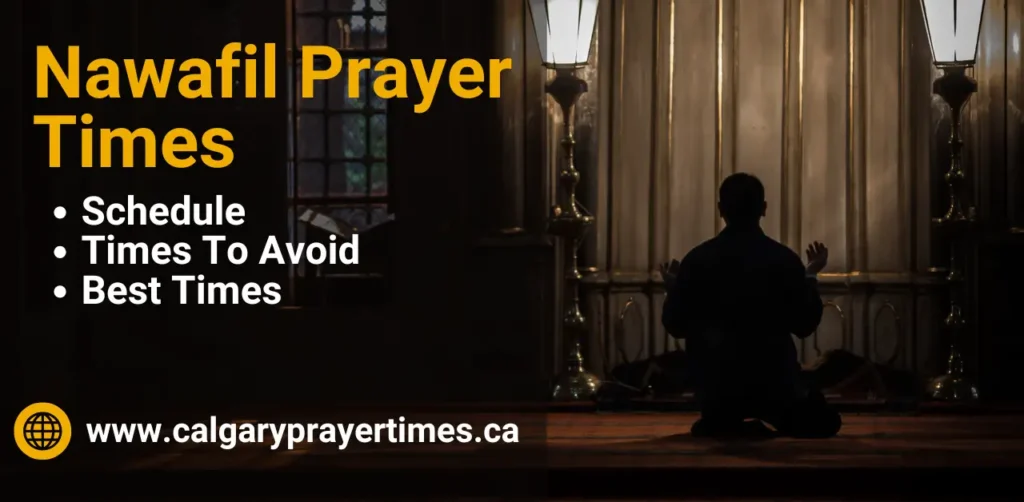Nawafil Prayers Time Detail About Tahajjud & Others

When talking about Nawafil prayer times, there is no specific time for them. Anyone can pray them at any time. These are optional prayers that can be offered with the intention of earning reward, gratitude, or any other good intention. There is no sin in not praying them.
However, there are certain times when it is forbidden to offer them, and these times are mentioned in Ahadees and other scholarly books.
Timetable For Nawafil Prayers
| Nafl Prayer | Time | Rakats |
|---|---|---|
| Tahajjud | Last third of the night | Varies (usually 2+ Rakats) |
| Ishraq | After sunrise (about 15-20 minutes after) | 2 or 4 Rakats |
| Duha/Chasht | After sun rises higher (mid-morning) | Varies (2-4 Rakats) |
| Awwabin | After Maghrib (right after the obligatory Maghrib prayer) | 6 Rakats |
| Tahiyyatul Wudu | After performing ablution (Wudu) | 2 Rakats |
| Tahiyyatul Masjid | Upon entering the mosque | 2 Rakats |
Times To Avoid Nawafil Prayers
Islamic teachings specify certain times during the day when Muslims should refrain from performing Nawafil prayers. These are times that have been mentioned in hadiths, and avoiding prayer during these times is for respecting the boundaries set by Islamic law.
- After Fajr until Sunrise: It is recommended not to perform Nawafil prayers right after the Fajr prayer until the sun has fully risen. This is roughly about 15 minutes after sunrise. The reason is that the sun rises between the horns of Shaytan, and this time is observed by disbelievers for worship.
- Midday (Zawal): Just before the Dhuhr prayer, there is a brief period when the sun is at its zenith (its highest point in the sky), known as Zawal. During this time, which lasts approximately 10 to 15 minutes before Dhuhr begins, performing Nawafil is also prohibited.
- After `Asr Prayer: Once you have offered your Asr prayer, it is advised not to pray any Nawafil until sunset. This rule applies from the time you perform the Asr prayer, not from the start of its prescribed time. This precaution helps avoid any confusion with the times disbelievers may perform rituals, as the setting sun is also associated with the worship of other deities in some cultures.
These rules help ensure that Muslims differentiate their worship from practices not approved in Islam and maintain the purity and distinctiveness of their prayers. This guidance comes from a hadith narrated by Imam Muslim in his Sahih, where the Prophet Muhammad (peace and blessings be upon him) outlined these times to avoid voluntary prayers.
Best Time for Nawafil Prayers
Although Nawafil prayers can be offered at any time, some moments are especially blessed, and praying during these times carries greater rewards.
1. The Last Third of the Night (Tahajjud)
- One of the best times for voluntary prayers.
- It is said that Allah descends to the lowest heaven and accepts prayers during this time.
- Perfect for making Dua, seeking forgiveness, and strengthening one’s connection with Allah.
2. After Fajr, But Not Immediately (Ishraq Prayer)
- Prayed 15-20 minutes after sunrise.
- Considered equivalent to the reward of an Umrah (minor pilgrimage) according to some hadiths.
3. Mid-Morning (Duha/Chasht Prayer)
- Prayed when the sun has risen high but before Dhuhr begins.
- Brings sustenance, peace of mind, and earns great rewards.
4. After Maghrib (Awwabin Prayer)
- Performed right after the obligatory Maghrib Salah.
- Highly encouraged for those who wish to increase their good deeds.
5. Before and After Obligatory Prayers
- The Prophet Muhammad (peace be upon him) often prayed Sunnah and Nawafil before and after Fard prayers, which adds to one’s spiritual rewards.
Conclusion
Nawafil prayers are optional yet highly rewarding acts of worship that can be performed at almost any time. However, there are a few prohibited periods when they should be avoided. Observing these prayer times helps maintain the sanctity of Islamic worship while maximizing the spiritual benefits of voluntary prayers.
